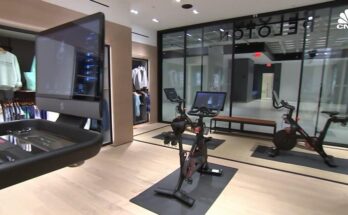A mat is not necessary for the Peloton bike, but it can protect your floor and stabilize the equipment. Many users choose to use a mat for these benefits.
Engaging in at-home fitness routines with the Peloton bike has gained considerable popularity. Enthusiasts often question the necessity of additional accessories, such as a mat. While the bike can effectively function without one, a mat serves as a barrier between the heavy equipment and your flooring, safeguarding against scratches and potential damage.
It also absorbs vibrations and noise during intense workouts, enhancing the overall experience. Opting for a mat can ensure a more stable base, especially on slippery surfaces. As comfort, cleanliness, and equipment maintenance grow in concern for dedicated cyclists, a high-quality mat becomes a wise investment in preserving both your workout space and your Peloton bike.

Credit: www.onepeloton.com
Peloton Setup Essentials
Setting up your Peloton is an exciting journey. You aim for comfort, safety, and the best riding experience. Beyond the bike itself, certain accessories add value to your workout routine. Each piece of equipment plays its part, and perhaps none is more vital than the mat. Let’s explore the essentials you need for your rides and why a mat is a crucial element of your setup.
Key Equipment For Your Rides
A well-thought-out Peloton setup enhances your performance. Focus on these essentials:
- Cycling shoes with cleats for a secure pedal connection
- Heart rate monitor to track your fitness level
- Water bottle to stay hydrated during intense workouts
- Weights for upper body exercises
- Headphones for immersive sound without distractions
- Mat to safeguard your floor and bike
Mat Purpose: Protecting Your Floor And Equipment
The right mat for your Peloton does more than just sit pretty. It’s a multi-tasker. Consider what it does:
| Mat Function | Benefit |
|---|---|
| Shield Floor | Prevents scratches and sweat damage |
| Stabilize Bike | Keeps the Peloton firmly in place |
| Reduce Noise | Minimizes disruption to others |
| Absorb Vibration | Lessens bike wear and improves comfort |
A mat is not just recommended; it’s practically essential. It plays a key role in protecting your investment. Your floor stays pristine, your rides are steady, and the noise level drops.
The Debate: To Mat Or Not To Mat
Choosing the right setup for your Peloton brings up a common question. Do you need a mat? Some riders swear by it, while others see no need. Let’s explore both sides of the story.
Arguments For Skipping The Mat
Many Peloton enthusiasts believe that a mat is not essential. Here are reasons they give:
- Stable flooring: If you have a hard, even floor, your bike might stand firm without a mat.
- Easy to clean: No mat means less laundry. You can quickly wipe the floor clean.
- Saves space: Without a mat, your workout area is less cluttered.
- Cost-efficient: Skipping the mat saves money.
Reasons A Mat Might Be Necessary
Others argue that a mat is a must-have for your Peloton. Here’s why:
- Protection: A mat guards your floor against sweat and pressure marks.
- Stability: It provides extra grip, keeping the bike stable during intense workouts.
- Noise reduction: Mats can dampen the noise, useful in shared living spaces.
- Comfort: Doing stretches or other exercises off the bike is more comfortable on a mat.
Exploring Mat Alternatives
Delving into the world of indoor cycling, one might ponder the necessity of a mat beneath their Peloton bike. While Peloton sells their own mat, it’s not the only solution for keeping your floor safe and reducing noise. There are various substitutes that might fit your space and budget even better. This section explores some inventive and cost-effective alternatives that ensure your ride remains stable and your floors protected.
Diy Solutions For Peloton Stability
Creativity can lead to practical, homemade fixes that safeguard your space. Look around; maybe you already have what you need at home. Here are some DIY mat alternatives:
- Old Yoga Mats: Double them up for extra cushioning.
- Interlocking Foam Tiles: They’re affordable and customizable.
- Heavy-Duty Rubber Mats: Often found in garages, they’re very durable.
Each solution provides a stable foundation and protects floors from sweat and scratches. For the best fit, ensure dimensions match your Peloton’s footprint.
Commercial Products As Mat Substitutes
If you’re not into DIY, there are commercial products that can be as effective as a proper cycling mat. They come ready to use and are designed to withstand weight and motion. Consider these options:
| Product Type | Pros | Cons |
|---|---|---|
| Exercise Equipment Mats | Specifically designed for exercise gear. | May be more expensive. |
| Industrial Anti-Fatigue Mats | Durable and shock-absorbent. | Not always suited for equipment. |
| Thick Carpet Runners | Offers cushioning and noise reduction. | Harder to clean and may slide. |
These options not only stabilize the bike but also provide a level of noise dampening. Opt for a mat that is slip-resistant and easy to maintain for hassle-free workouts.

Credit: www.swimquest.com
User Experiences With Mats
Many Peloton riders add a mat under their bikes. They find it changes their whole workout. Let’s see what they say.
Positive Feedback From Mat Users
Mats bring benefits to the Peloton experience. Users share their thoughts:
- Stability: A mat grips the floor.
- Equipment Protection: It saves your bike from scratches.
- Noise Reduction: Mats absorb sound.
- Sweat Collection: Sweat drops on the mat, not the floor.
Challenges Faced Without A Mat
Skipping the mat has its setbacks. Users have faced issues:
| Challenge | Effect |
|---|---|
| Slipping | Bike moves during rides. |
| Floor Damage | Pressure marks and scratches appear. |
| Sound Amplification | Noises annoy housemates or neighbors. |
| Messy Floors | Sweat stains need cleaning. |
Without a mat, floors get dirty and workouts risky!
Making The Right Choice
Embarking on your Peloton journey brings excitement and commitment to fitness. A key choice lies in whether you need a mat to accompany your Peloton. This decision can enhance your workout experience. Consider the space and balance between cost and benefits to make the best decision.
Assessing Your Personal Workout Space
Where you ride your Peloton affects your mat decision. Different factors matter:
- Floor Type: Hardwood and carpet mean different needs.
- Space Size: Measure the area to match mat dimensions to your room.
- Vibration: Does your workout disturb others? A mat might reduce noise.
- Sweat: Consider a mat to protect floors from sweat during intense rides.
Balancing Budget And Benefits
A mat adds to the total investment of your Peloton setup. However, it offers some advantages:
| Benefit | Description |
|---|---|
| Protection | Shields the floor from scratches and sweat. |
| Stability | Keeps the bike stable and prevents slipping. |
| Comfort | Softens the space for yoga or stretching off the bike. |
| Cleanliness | Easy to clean, helping maintain a hygienic workout area. |
Evaluate these benefits against the cost. Quality mats vary in price but can be a worthy investment for a serious cyclist’s space.
Expert Recommendations
Seeking expert opinions gives clarity on whether a mat is necessary for your Peloton workouts. Here’s what professionals say.
Fitness Trainers’ Take On Using A Mat
Fitness experts weigh in on the need for a mat under your Peloton bike or treadmill. Trainers emphasize protection and stability.
- Floor safeguarding: Mats prevent scratches and damage to flooring.
- Equipment steadiness: They help keep the machine firmly in place.
- Noise reduction: Less vibration equals less noise during workouts.
- Sweat management: Mats absorb sweat, keeping the area clean.
Experts suggest a high-quality PVC or rubber mat. These materials are durable and easy to clean.
Peloton’s Official Stance
Peloton also offers guidance on using mats. They recommend using one for several reasons:
| Reason | Benefit |
|---|---|
| Equipment Longevity | Extends the life of your equipment |
| Stability | Prevents rocking or movement during use |
| Cleanliness | Keeps your workout area free from sweat and debris |
Peloton endorses a mat for a more effective and enjoyable exercise experience. They design mats to complement their machines perfectly.

Credit: www.onepeloton.com
Frequently Asked Questions On Do You Need A Mat For The Peloton
Do I Need To Put A Mat Under My Peloton?
Yes, placing a mat under your Peloton bike can protect your flooring and stabilize the equipment.
Does Peloton Have To Be On Mat?
Using a mat for your Peloton bike is not mandatory, but it’s recommended to protect floors and improve stability. A mat can also reduce noise during workouts.
Do I Need A Mat Under My Stationary Bike?
Yes, using a mat under your stationary bike protects your floor and stabilizes the bike, reducing noise and vibration.
What Are The Benefits Of The Peloton Mat?
The Peloton mat provides stability for your bike, reduces noise, protects floors, and enhances your workout area’s appearance. It’s durable and easy to clean, offering long-lasting use.
Conclusion
Deciding on a mat for your Peloton can enhance your workout experience. It’s all about stability, floor protection, and noise reduction. Don’t overlook the longevity it brings to both equipment and your exercise space. So, as you commit to your fitness journey, consider a mat a small yet impactful investment.
Choose wisely, ride smoothly.


